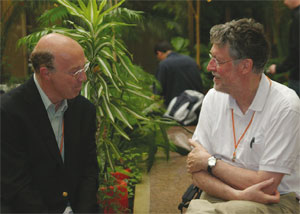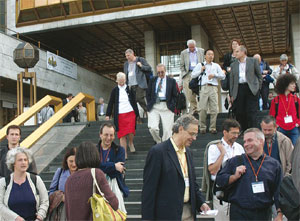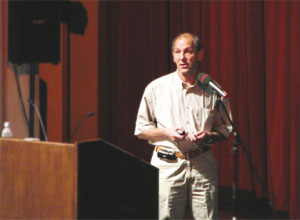Moscow hosted this year’s major summer conference, which presented the latest news across a broad range of topics. Gennady Kozlov and Simon Eidelman report.
In summer 1976, the International Conference on High Energy Physics (ICHEP), known traditionally as the Rochester conference, was held in Tbilisi, the last time it would take place within the USSR. Thirty years later, the Rochester conference returned to Russia, when around a thousand physicists from 53 countries attended ICHEP’06, held on 26 July – 2 August in the Russian Academy of Sciences in Moscow. The extensive scientific programme contained the customary mixture of plenary reports, parallel sessions and poster presentations. For six days, participants discussed key issues in high-energy physics, ranging from astrophysics and cosmology, through the physics of heavy-ions, rare decays and hadron spectroscopy, to theoretical scenarios and experimental searches beyond the Standard Model. Topics also included Grid technology for data processing, new accelerators and particle detectors, and mathematical aspects of quantum field theory and string theory.

In his opening speech, the co-chair of the conference, Victor Matveev, emphasized that the entire community of Russian high-energy physicists was honoured to host the major international conference of 2006. The participants were also greeted by the director of the Budker Institute of Nuclear Physics (BINP) and co-chair of the conference, Alexander Skrinsky, and deputy rector of the Lomonosov Moscow State University, Vladimir Belokurov. The vice-chair of the organizing committee, and director of the Joint Institute for Nuclear Research (JINR), Alexei Sissakian then spoke about the structure of ICHEP’06 and its scientific programme.
Duality, QCD and heavy-ions
On the theory side, the progress in so-called “practical theory” is evident, primarily in the sophisticated calculations in quantum chromodynamics (QCD) presented by Giuseppe Marchesini of Milano-Bicocca University and Zvi Bern of the University of California, Los Angeles. Gerritt Schierholz from DESY, Adriano Di Giacomo of Pisa University and Valentin Zakharov of the Institute for Theoretical and Experimental Physics (ITEP), Moscow, explained the remarkable achievement of the splendid harmony between analytical calculations and the results obtained on the lattice using dynamical quarks.
The theoretical discussions emphasized the concept and use of gravity-gauge duality in a framework generalizing the anti-de Sitter space/conformal field theory correspondence. This duality is a conjectured relationship between confining gauge theories in four dimensions on the one hand, and gravity and string theory in five and more dimensions on the other. DESY’s Volker Schomerus described how, when applied to QCD, this approach reproduces numerous non-perturbative features of strong interactions, from the low-energy hadron spectrum through Regge trajectories and radial excitations to quark counting rules. On the experimental side, Pavel Pakhlov of ITEP Moscow, Antonio Vairo of Milano University and Alexandre Zaitsev of the Institute for High Energy Physics (IHEP) Protvino, reported on the numerous candidates for exotic hadronic states, both with light quarks only and with heavy quarks and/or gluons, that have been confirmed or newly reported by teams from the VES experiment in Protvino, BES II in Beijing, E852 at Brookhaven, CLEOc at Cornell, Belle at KEK, and BaBar at SLAC. These exotic states have still to be interpreted theoretically, within either gravity/gauge duality or more traditional approaches.

The Relativistic Heavy Ion Collider (RHIC) at the Brookhaven National Laboratory is intensively studying a relatively new area of QCD – the properties of matter at high temperatures and high particle densities. Timothy Hallman from Brookhaven, Larisa Bravina of the Skobeltsyn Institute of Nuclear Physics (SINP) Moscow University, Nu Xu of Lawrence Berkeley National Laboratory (LBNL), and Oleg Rogachevsky of JINR, among others, presented numerous experimental results, some of which were reported for the first time. These results suggest, quite surprisingly, as Xin-Nian Wang of LBNL explained, that collisions of highly energetic ions at RHIC result in the formation of strongly coupled quark–gluon matter, rather than weakly interacting quark–gluon “gas”. Here, too, gravity/gauge duality can reflect the most remarkable properties such as the low viscosity of quark–gluon “fluid”, jet quenching and so on.
Karel Safarik from CERN and Lyudmila Sarycheva of SINP described how QCD will be probed at even higher temperatures at the Large Hadron Collider (LHC) at CERN. Sissakian and Alexander Sorin of JINR reported on plans at the JINR Nuclotron for complementary studies of matter at lower temperatures but high baryon number densities; there are also plans at GSI, Darmstadt. Most likely, matter at these extreme conditions will exhibit new surprising properties in addition to those observed at RHIC.
Quarks and leptons
With the B-factories and Tevatron operating, this conference witnessed impressive progress in flavour physics, including B meson decays, processes with CP violation, b → s and b → d transitions and so on, which featured in the review talks by KEK’s Yasuhiro Okada and Masashi Hazumi and Robert Kowalewski from Victoria University. The discovery of Bs oscillations at the Tevatron was one of the highlights of the year. Doug Glenzinski of Fermilab reported on these results from the CDF collaboration, which reveal a mass difference between the mass eigenstates equal to 17.31 ps-1 (central value). All data on flavour physics, including CP violation and Bs oscillations, are now well described by the Standard Model and Cabibbo–Kobayashi–Maskawa theory. Thus, the Standard Model once again has passed a series of highly non-trivial tests, this time in the heavy-quark sector.

Dugan O’Neil of Simon Fraser University and Florencia Canelli from Fermilab were among those presenting precision measurements of the masses of the heaviest known particles, which are still an important aspect of experimental high-energy physics. New results presented at the conference were based mainly on data from the CDF and D0 collaborations at the Tevatron. The top quark became lighter than it had been at the Beijing Conference in 2004 (CERN Courier January/February 2005 p37): now its mass is 171.4±2.1 GeV. Measurements of the W-boson mass are also more accurate. Making use of these data, the Electroweak Working Group has produced a new fit for the mass of the Standard Model Higgs boson, mh = 85-28+39 GeV, which is somewhat lower than before. According to this fit, the upper limit on the Higgs boson mass is 166 GeV, as Darien Wood of Northeastern University explained. Yuri Tikhonov from BINP presented recent high-precision measurements of the mass of the τ lepton at Belle and at the KEDR detector at BINP, which have confirmed lepton universality in the Standard Model.
Beyond the Standard Model
The conference paid considerable attention to the search for new physics. Numerous possible properties beyond the Standard Model are even more strongly constrained than before, including supersymmetry; extra space–time dimensions; effective contact interactions in the quark and lepton sectors; additional heavy-gauge bosons; excited states of quarks and leptons; and leptoquarks. This was emphasized in various talks by Elisabetta Gallo of INFN Florence, Roger Barlow of Manchester University, Herbert Greenlee of Fermilab, Stephane Willocq of Massachusetts University and others. Yet most of the community is confident that new physics is within the reach of the LHC. Indeed, more theoretical scenarios for tera-electron-volt-scale physics beyond the Standard Model were presented at the conference, in talks for example by Rohini Godbole of the Indian Institute of Science, Alexander Belyaev of Michigan University, Pierre Savard of Toronto University and TRIUMF, Sergei Shmatov and Dmitri Kazakov of JINR, and Satya Nandi of Oklahoma University. Notable exceptions were Holger Bech Nielsen of the Niels Bohr Institute, who argued that even the Higgs boson might never be discovered (for a not necessarily scientific reason), and Mikhail Shaposhnikov of Lausanne University and the Institute for Nuclear Research (INR) Moscow, who defended his “nuMSM” model, which accounts for all existing data in particle physics and cosmology at the expense of extreme fine-tuning.

CERN’s Fabiola Gianotti raised much interest by discussing the tactics for early running at the LHC, reflecting the community’s thirst for new physics and the high expectations for the LHC. More generally, there was a sense of expectation as this was the last Rochester meeting before the start-up of the LHC.
The properties of neutrinos continue to be among the top issues in high-energy physics. Geoff Pearce of the Rutherford Appleton Laboratory presented the first data from a new player, the MINOS collaboration, which support the pattern of the oscillations of muon neutrinos observed by the Super-Kamiokande and KEK-to-Kamioka (K2K) experiments. Other collaborations presented refined analyses of their data in talks by Kiyoshi Nakamura of KamLAND and Tohoku University, Yasuo Takeuchi of Super-Kamiokande and Tokyo University, keVin Graham of the Sudbury Neutrino Observatory and Carleton University, Valery Gorbachev of the Russian American Gallium Experiment and INR Moscow, and Yuri Kudenko of K2K and INR. These agree overall on oscillations of both electron and muon neutrinos, with evidence for oscillations of muon neutrinos into tau neutrinos confirmed by the Super-Kamiokande experiment. Also, the KamLand experiment has confirmed and enhanced the case for geo-neutrinos. The dominating oscillation parameters are now measured with the precision of 10–20%, except for the smallest mixing angle θ13 and a possible CP-violating phase, as Regina Rameika of Fermilab, Ferruccio Feruglio of Padova University and Kunio Inoue of Tohoku University explained. Interestingly, the range of neutrino masses 0.01 eV < mν < 0.3 eV, suggested by neutrino oscillation experiments, as well as by cosmology and direct searches, is in the right ballpark for leptogenesis – a mechanism for the generation of the matter–antimatter asymmetry in the universe.
Astroparticle physics is another area of continuing interest. Anatoli Serebrov of Petersburg Nuclear Physics Institute presented a new measurement of the neutron lifetime, which makes a significant contribution to the calculation of the abundance of primordial helium-4 in the universe. Techniques for the direct and indirect detection of dark-matter particles are rapidly developing, with indications for positive signals from DAMA and EGRET still persisting, as described by Alessandro Bettini of INFN Padova and by Kazakov. In cosmic-ray physics, the Greisen–Zatsepin–Kuzmin cut-off in the spectrum of ultra-high-energy cosmic rays is still an issue. Giorgio Matthiae of Rome University “Tor Vergata” presented the first data from the Pierre Auger Observatory. Masahiro Teshima of the Max Planck Institute, Munich, and Gordon Thomson of Rutgers University presented the new analyses by the AGASA and HiRes collaborations, respectively. As a result, as Yoshiyuki Takahashi of Alabama University explained, the discrepancy between different experiments is now reduced.
Traditionally, the Rochester conferences discuss future accelerators for high-energy physics and new developments in particle detection, and receive reports from the International Committee for Future Accelerators (ICFA) and the Commission on Particles and Fields (C11) of the International Union of Pure and Applied Physics (IUPAP). This was particularly timely in Moscow in view of the upcoming start-up of the LHC. At present, the scientific community is discussing a new megaproject – the large linear electron–positron collider with an energy of 0.5–1.0 TeV, known as the International Linear Collider (ILC). Together with the LHC, the ILC will be a unique tool for studying fundamental properties of matter and the universe. The talks by Skrinsky, DESY’s Albrecht Wagner and Rolf Heuer, and CERN’s Lyn Evans discussed the prospects for the project, including the contribution from Russia. Gregor Herten of Freiburg University, who heads the IUPAP Commission (C11), said that fundamental science is very important in Russia, and that the research conducted by Russian scientists is highly esteemed around the world.
Valery Rubakov of INR Moscow closed the conference with a summary talk emphasizing both the current confusion of some theorists regarding new physics and the impact of the LHC on the entire field and beyond. The hope is that, with results from the LHC, at least some of the numerous questions raised in Moscow will be answered at the next Rochester conference, to be held in summer 2008 in Philadelphia.
The ICHEP’06 conference was jointly organized by the Russian Academy of Sciences, the Russian Federation (RF) Ministry of Education and Science, the RF Federal Agency on Science and Innovation, the RF Federal Agency on Atomic Energy, the Lomonosov Moscow State University and JINR, the main coordinator of the meeting. It was financially supported by IUPAP, the Russian Foundation for Basic Research, RAS, JINR and the RF Federal Agency on Science and Innovation.
• The authors are indebted to Valery Rubakov for his help in preparing this article.





